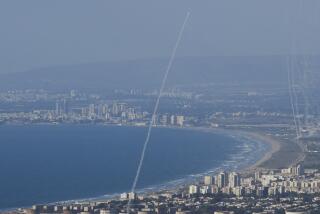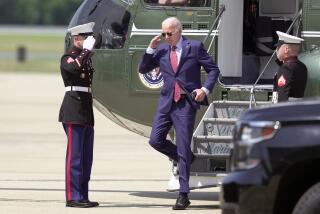Britain Sending More Warships to Gulf : Buildup: A destroyer and three mine-hunters will join the international flotilla enforcing U.N. sanctions against Iraq.
MANAMA, Bahrain — Declaring that Western weapons have already made “further aggression a risky venture indeed” for Iraq, British Defense Secretary Tom King disclosed Wednesday that his government is dispatching more warships to the Persian Gulf.
King, who is touring the region, told reporters on board the frigate Battleaxe in port in Bahrain that three mine-hunters will be sent from the eastern Mediterranean, along with the destroyer Gloucester from Britain. They will join three British warships in the gulf.
In the little more than a week since the Bahraini government approved use of its air bases by British forces, this small island nation, which is linked to the Saudi mainland by a 15-mile-long causeway, has begun to bristle with foreign arms.
A 12-plane squadron of Tornado fighter-bombers arrived Tuesday at Manama’s Muharraq International Airport. In addition, a battery of Rapier anti-aircraft missiles has been deployed to protect the Tornado base.
Military sources said American aircraft are using another airfield, on the southern part of the island.
King said the British government has no immediate plans to send ground troops to the region, but “we are keeping all these matters under review.”
He spoke of the “total unacceptability” of Iraq’s invasion and annexation of Kuwait and added, “We rule nothing out.”
With the eight ships of the U.S. Middle East Task Force operating in Persian Gulf waters, and warships from France, Australia, Italy, the Netherlands, Spain, Belgium and Greece pledged to the gulf defenses, the waterway that carries more than 25% of the world’s oil to markets--or did so before the blockade of Iraqi and Kuwaiti ports--promises to be thick with warships.
King said British, American and other forces are attempting to harmonize their operations, “making sure we don’t trip each other up.” So far, no multinational naval command has been established.
All the Western countries involved have separate intelligence operations tracking Iraqi shipping, King said, but when asked whether there is a “big board” somewhere collating intelligence reports, he replied, “The answer is yes.”
The Iraqi response to the teeming patrol forces in the gulf, which are backed by three U.S. aircraft carriers off the Arabian Peninsula, has been to lie low, British military officers said.
Lt. Comdr. Nick Harland, second in command of the Battleaxe, said, “I think it’s already become a very effective embargo.”
He said the Battleaxe and its sister ships of what the British call their Armilla patrol have not sighted an Iraqi ship for 10 days. The last was an outbound tanker, riding high and empty. No attempt was made to stop or to board the ship, he said, pointing out that the encounter took place before last weekend’s U.N. Security Council resolution permitting the blockaders to use force.
With the balance of forces sharply against him at sea, Iraqi President Saddam Hussein has ordered his tanker skippers not to resist boarders. There have been no reports that his navy of five frigates and eight missile boats has left Iraqi waters at the top of the gulf.
But among the Western ships, “it’s getting very crowded,” Harland said. Nevertheless, he added, sometimes “you can go for some hours without seeing another warship.” U.S. and British ships coordinate movements on a daily basis and patrol separate areas.
“We all talk to each other when we pass,” he said, “trying to develop easy relations. . . . . We also talked to the Soviets (a single frigate deployed in the gulf), and they seemed to be very friendly.”
On the Armilla patrol, ships at sea are at a condition of readiness called “defense quarters,” with 50% of the crew on watch at all times.
The highest concerns are hostile aircraft and mines. No mining has been confirmed so far, but it is not a difficult operation. During the 1980-88 war between Iran and Iraq, mines were laid in the gulf from low-flying helicopters and speedboats.
The Battleaxe, 425 feet long, was designed for anti-submarine warfare but carries a variety of armaments, including Exocet anti-ship missiles, a Seawolf air-defense missile system and two Lynx helicopters, which, Harland said, “can do all sorts of things.”
British marines on board the Battleaxe conducted a demonstration Wednesday to show that in an air attack, every weapon would be thrown into the battle. Marine teams operate a hand-held Javelin anti-aircraft missile launcher.
“You just stand up here against this rail, get the plane in your sights and fire,” one explained.
More to Read
Sign up for Essential California
The most important California stories and recommendations in your inbox every morning.
You may occasionally receive promotional content from the Los Angeles Times.










